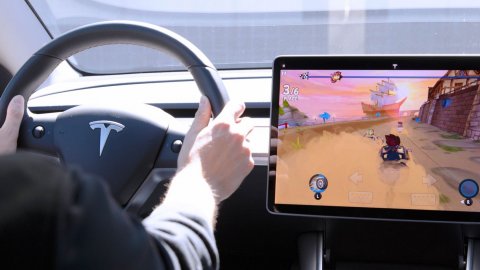
Tesla
Tesla has announced that it will shortly release an update for its cars that will prevent video games from being played via the cockpit-mounted touch screen while the vehicle is in motion. The decision was made after pressure from the US government in recent days.For the uninitiated, Tesla cars have a feature called Passenger Play that allows anyone inside the vehicle to play games. video games thanks to the large touch screen in the passenger compartment. The new update will limit the use of this feature, so that it can only be activated when the car is not moving.
The Passenger in Play function of Tesla cars As reported by The Guardian, last week, the National Highway Traffic Safety Administration opened formal investigations into Tesla cars sold from 2017 to present. So let's talk about the 3, S, X and Y models that have the Passenger play function. After the analysis, the institution came to the conclusion that this feature could distract the driver while driving (even if the player is a passenger), thus increasing the risk of accidents. Despite the update launched by Tesla, NHTSA says it will continue its investigation of Tesla vehicles in the future as well.
"The Vehicle Safety Act prohibits manufacturers from selling vehicles with defects that pose unreasonable safety risks," including technologies that distract drivers from safe driving, ”says an NHTSA spokesperson.
Have you noticed any errors?
Biden is gambling that clean hydrogen could be the next Tesla
When US president Joe Biden took office in January, one of his first stated climate change priorities was resurrecting one of the federal government’s most maligned and scandal-ridden programs. Now he’s following through with a billion-dollar gamble on a startup that’s taking a unique spin on a controversial emerging energy source.
On Dec. 23, the Department of Energy’s Loan Programs Office announced its first guarantee under Biden: $1.04 billion for Monolith Nebraska, which uses renewable electricity to split natural gas into hydrogen gas and a solid called carbon black. The hydrogen is used to produce agricultural fertilizer; the carbon black will be sold to Goodyear to make tires. Unlike most natural gas-fed hydrogen plants, the company’s proprietary process produces no carbon emissions, Monolith says, making it a clean alternative for two industries—fertilizer and rubber—that have notorious carbon footprints. It’s also the first non-nuclear project to receive support from the LPO since 2016.
The Loan Programs Office is responsible for helping cutting-edge clean energy startups get from the lab to full-scale commercialization. It sits on $44 billion in unused, already-Congressionally-approved loans and loan guarantees, making it one of the government’s most potent existing tools to confront climate change, especially now that Biden’s Build Back Better spending bill seems likely to crumble. Its greatest success was a $500 million loan in 2013 to an electric vehicle startup called Tesla—now a trillion-dollar behemoth.
But throughout Donald Trump‘s administration and the later years of Barack Obama’s, the LPO was practically a ghost town. Bureaucrats were spooked out of placing taxpayer bets on the next potential Elon Musk because of the massive political blowback from the office’s greatest perceived failure: Solyndra, a California solar panel manufacturer that took a $535 million guarantee in 2009 and quickly went belly-up when unanticipated supply chain shifts rendered its technology obsolete. Solyndra was used by Republicans as a catchall anti-climate bludgeon for years, even though most economists today agree that taking risks on uncertain new technologies is the whole point of the LPO, and a zero-percent failure rate would just indicate that taxpayers were backing loans that probably didn’t need public support.
For the LPO under Biden (led by former solar power entrepreneur Jigar Shah), the real appeal of Monolith i shoring up support and market share for the nascent clean hydrogen industry. Hydrogen is poised to be one of the fastest-growing fuels of the future, and holds promise to be the leading source of zero-carbon power for steel factories and other industrial facilities. The US, as well as many countries in Europe, Latin America, and the Middle East, are scrambling to lay the groundwork for green hydrogen production and exports. But the infrastructure to transport it, and evidence that it can be produced at scale, at a competing cost to carbon-intensive alternatives, don’t yet exist. That makes a company like Monolith a potentially risky bet for private-sector investors—but right in the sweet spot for the LPO, which is finally ready to risk the next Solyndra for the sake of the next Tesla.